Design and Thermodynamic Analysis of CO2 Liquefaction Processes for Onboard Carbon Capture and Storage
Abstract
1. Introduction
2. Materials and Methods
2.1. Description of CO2 Liquefaction
- (1)
- Compression: The captured gas undergoes a three-stage low-pressure compression, followed by a two-stage high-pressure compression. After each stage, the gas is cooled in an intercooler. At the inlet of the first high-pressure compressor, the gas discharged from the aftercooler of the third low-pressure compressor is mixed with the separated CO2 vapor, which has been heated in the heat exchanger.
- (2)
- Condensation: The compressed CO2 becomes saturated in the aftercooler and is subsequently supercooled in the heat exchanger. During this process, heat is transferred from the compressed CO2 to the separated CO2 vapor.
- (3)
- Expansion: The high-pressure supercooled liquid expands through the Joule–Thomson valve, producing a low-temperature vapor–liquid mixture. In the downstream separator, CO2 is separated into gas and liquid phases. The separated CO2 vapor is recycled to the inlet of the first high-pressure compressor via the heat exchanger, while the liquified CO2 is transferred to the storage tank.

- (1)
- Compression and condensation: The ammonia refrigerant undergoes three stages of compression, which raise its pressure and temperature. Each stage has its aftercooler that dissipates heat from the compressed gas. Then, after the third-stage compressor, the high-temperature and high-pressure refrigerant is condensed into a liquid state in a condenser.
- (2)
- Expansion: The high-pressure liquid refrigerant is expanded through a Joule–Thomson valve, resulting in a low-pressure mixture of liquid and vapor.
- (3)
- Evaporation: The low-temperature refrigerant absorbs heat from the captured CO2 stream through the heat exchanger. This heat input causes the refrigerant to evaporate, completing the cycle and preparing it for compression.
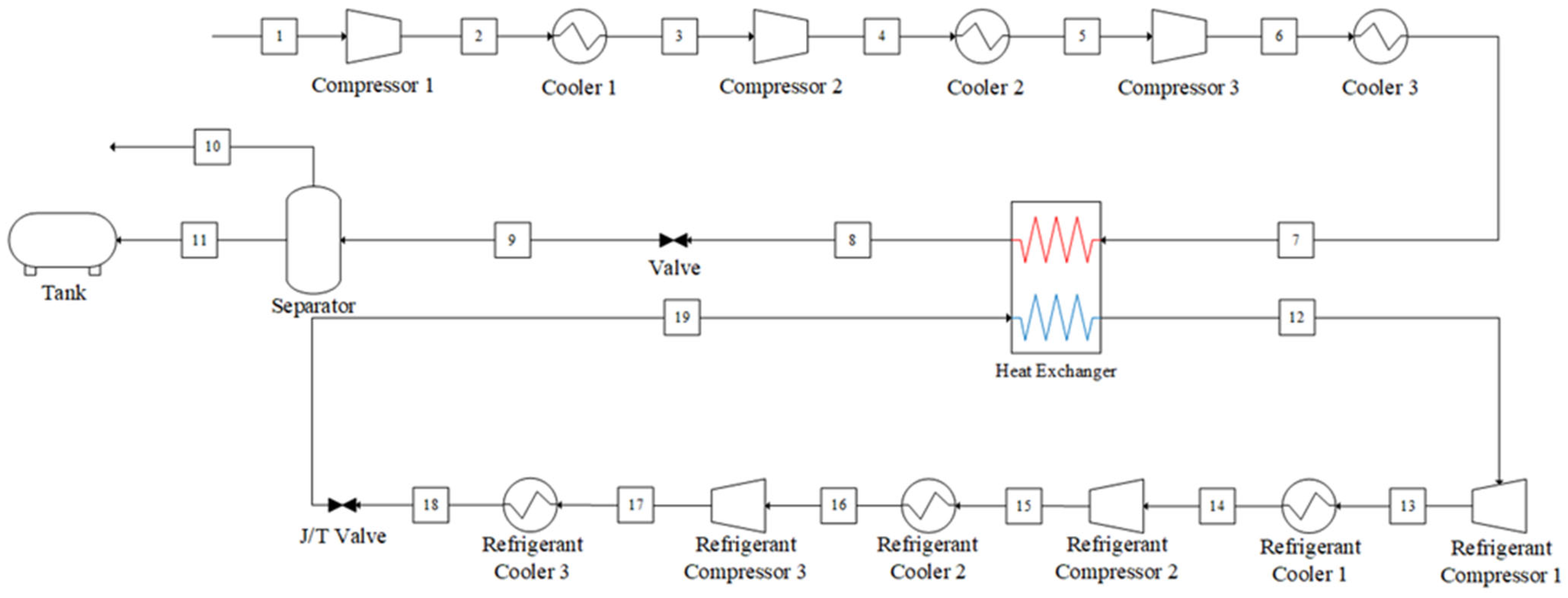
2.2. Basis of Design
- Compressor adiabatic efficiency: 75% [20];
- Maximum compressor pressure ratio: 3 [20];
- Minimum approach temperature in heat exchangers: 3 °C [21];
- Refrigerant side inlet and outlet pressures in the vapor compression refrigeration cycle heat exchanger: 101.3 kPa and 100 kPa, respectively (vacuum condition considered);
- Storage pressure and temperature: 1500 kPa, −27.71 °C [29];
- Sea water temperature: 30 °C [29].
2.3. Design of CO2 Liquefaction Systems
2.4. Thermodynamic Performance Indicators
2.4.1. Specific Energy Consumption (SEC)
2.4.2. Establishing a Common Thermodynamic Framework: The Coefficient of Performance (COP)
2.4.3. Defining and Validating a System-Level for the Linde–Hampson Cycle
2.4.4. Complementary Insights from SEC and COP
3. Results and Discussion
3.1. Validation of the COP Evaluation Method for the Linde–Hampson Cycle
3.2. Comparison of the Two CO2 Liquefaction System Performance
4. Conclusions
Author Contributions
Funding
Data Availability Statement
Conflicts of Interest
Nomenclature
| Abbreviations | |
| COP | Coefficient of performance |
| CO2 | Carbon dioxide |
| EEDI | Energy efficiency design index |
| FOM | Figure of merit |
| GHG | Greenhouse gas |
| H2 | Hydrogen |
| IMO | International maritime organization |
| LCC | Life cycle cost |
| LNG | Liquefied natural gas |
| MARPOL | International convention for the prevention of pollution from ships |
| MEPC | Marine environment protection committee |
| NH3 | Ammonia |
| NOx | Nitrogen oxide |
| OCCS | Onboard carbon capture and storage |
| SEC | Specific energy consumption |
| Variables | |
| Enthalpy of the stream entering the considered equipment or system (kJ/kg) | |
| Enthalpy of the stream exiting the considered equipment or system (kJ/kg) | |
| Mass flow rate through the considered equipment or system (kg/s) | |
| Liquefied CO2 mass flow rate (kg/s) | |
| Mass flow rate of the refrigerant circulating through the heat exchanger (kg/s) | |
| Amount of heat removed from the system (kW) | |
| Total power consumption of the system (kW) | |
| Subscripts | |
| Inlet stream | |
| Linde–Hampson refrigeration cycle | |
| Outlet stream |
References
- Yi, C.J. A Study on Discussions on International Cooperation in response to Climate Change and Measures to Improve Domestic Legislation. Wonkwang Law Rev. 2024, 40, 101–120. [Google Scholar]
- Marine Environment Protection Committee (MEPC 80). Available online: https://www.imo.org/en/mediacentre/meetingsummaries/pages/mepc-80.aspx (accessed on 4 August 2025).
- Bilgili, L.; Ölçer, A.I. IMO 2023 strategy-Where are we and what’s next? Mar. Policy 2024, 160, 105953. [Google Scholar] [CrossRef]
- Jeong, S.; Kim, J.-S.; Kim, Y.-T. Optimization study of BOG re-liquefaction process for ammonia fueled ship. J. Adv. Mar. Eng. Technol. 2024, 48, 167–176. [Google Scholar] [CrossRef]
- IMO MEPC 83: GHG Requirements Approved, Taking Effect from 2028 [WWW Document] n.d. Available online: https://www.dnv.com/news/2025/imo-mepc-83-ghg-requirements-approved-taking-effect-from-2028/ (accessed on 2 September 2025).
- Xing, H.; Chang, S.; Ma, R.; Wang, K. EU MRV Data-Based Review of the Ship Energy Efficiency Framework. J. Mar. Sci. Eng. 2025, 13, 1437. [Google Scholar] [CrossRef]
- Al-Enazi, A.; Okonkwo, E.C.; Bicer, Y.; Al-Ansari, T. A review of cleaner alternative fuels for maritime transportation. Energy Rep. 2021, 7, 1962–1985. [Google Scholar] [CrossRef]
- Huy, N.Q.; Duong, P.A.; Nam, T.T.; Ha, T.T.T.; Ryu, B.R.; Kang, H. A novel proposal for a marine fuel cell system utilizes LNG as a sustainable and green fuel for the future of shipping. J. Adv. Mar. Eng. Technol. 2024, 48, 46–54. [Google Scholar] [CrossRef]
- Pavlenko, N.; Comer, B.; Zhou, Y.; Clark, N.; Rutherford, D. The Climate Implications of Using LNG as a Marine Fuel; International Council on Clean Transportation: Washington, DC, USA, 2020. [Google Scholar]
- Solakivi, T.; Paimander, A.; Ojala, L. Cost competitiveness of alternative maritime fuels in the new regulatory framework. Transp. Res. Part D Transp. Environ. 2022, 113, 103500. [Google Scholar] [CrossRef]
- DNV LNG Powers Unprecedented Year for Orders of Alternative-Fuelled Vessels. Available online: https://www.dnv.com/news/lng-powers-unprecedented-year-for-orders-of-alternative-fuelled-vesselss/?utm_source=chatgpt.com (accessed on 11 May 2025).
- Lloyd’s Register LNG’s Critical Role in Shipping’s Energy Transition. Available online: https://www.lr.org/en/knowledge/press-room/press-listing/press-release/2025/lngs-critical-role-in-shippings-energy-transition-revealed-in-lloyds-registers-latest-fuel-for-thought-report/?utm_source=chatgpt.com (accessed on 11 May 2025).
- KOGAS Global LNG Carrier Status. Available online: https://www.kogas.or.kr/site/eng/1060101020000 (accessed on 11 May 2025).
- Zanobetti, F.; Pio, G.; Bucelli, M.; Miani, L.; Jafarzadeh, S.; Cozzani, V. Onboard carbon capture and storage (OCCS) for fossil fuel-based shipping: A sustainability assessment. J. Clean. Prod. 2024, 470, 143343. [Google Scholar] [CrossRef]
- Lee, S.; Yoo, S.; Park, H.; Ahn, J.; Chang, D. Novel methodology for EEDI calculation considering onboard carbon capture and storage system. Int. J. Greenh. Gas Control 2021, 105, 103241. [Google Scholar] [CrossRef]
- Zhao, T.; Li, R.; Zhang, Z.; Song, C. Current status of onboard carbon capture and storage (OCCS) system: A survey of technical assessment. Carbon Capture Sci. Technol. 2025, 15, 100402. [Google Scholar] [CrossRef]
- Ansaloni, L.; Alcock, B.; Peters, T.A. Effects of CO2 on polymeric materials in the CO2 transport chain: A review. Int. J. Greenh. Gas Control 2020, 94, 102930. [Google Scholar] [CrossRef]
- Park, J.; Gbadago, D.Q.; Hwang, S. Efficient CO2 Dehydration and Liquefaction Processes for Onboard Carbon Capture Storage in Maritime Transport; Social Science Research Network (SSRN): Rochester, NY, USA, 2024. [Google Scholar] [CrossRef]
- Chen, F.; Morosuk, T. Exergetic and Economic Evaluation of CO2 Liquefaction Processes. Energies 2021, 14, 7174. [Google Scholar] [CrossRef]
- Seo, Y.; You, H.; Lee, S.; Huh, C.; Chang, D. Evaluation of CO2 liquefaction processes for ship-based carbon capture and storage (CCS) in terms of life cycle cost (LCC) considering availability. Int. J. Greenh. Gas Control 2015, 35, ISOPE-I-14-094. [Google Scholar] [CrossRef]
- Aliyon, K.; Mehrpooya, M.; Hajinezhad, A. Comparison of different CO2 liquefaction processes and exergoeconomic evaluation of integrated CO2 liquefaction and absorption refrigeration system. Energy Convers. Manag. 2020, 211, 112752. [Google Scholar] [CrossRef]
- Øi, L.E.; Eldrup, N.; Adhikari, U.; Bentsen, M.H.; Badalge, J.L.; Yang, S. Simulation and Cost Comparison of CO2 Liquefaction. Energy Procedia 2016, 86, 500–510. [Google Scholar] [CrossRef]
- Kim, J.-S.; Kim, D.-Y.; Kim, J.-S.; Kim, D.-Y. Thermodynamic and Economic Analysis of Cargo Boil-Off Gas Re-Liquefaction Systems for Ammonia-Fueled LCO2 Carriers. J. Mar. Sci. Eng. 2024, 12, 1642. [Google Scholar] [CrossRef]
- Firm Orderbook Anticipates 1000-Strong LNGC Fleet. Available online: https://www.rivieramm.com/news-content-hub/news-content-hub/firm-orderbook-anticipates-1000-strong-lngc-fleet-76930?utm_source=chatgpt.com (accessed on 11 May 2025).
- Twofold Increase in Lng Vessel Orders Playing out Against the Backdrop of Elevated Newbuilding Prices. Available online: https://www.offshore-energy.biz/twofold-increase-in-lng-vessel-orders-playing-out-against-the-backdrop-of-elevated-newbuilding-prices/?utm_source=chatgpt.com (accessed on 11 May 2025).
- Capital Maritime’s Approach to Decarbonisation: LNG Now and Ammonia Later. Available online: https://www.rivieramm.com/news-content-hub/news-content-hub/capital-maritimes-approach-to-decarbonisation-lng-now-and-ammonia-later-81705 (accessed on 11 May 2025).
- WinGD General Technical Data. Available online: https://wingd.com/products-solutions/engines/general-technical-data (accessed on 11 May 2025).
- Subramanian, N.; Madejski, P. Analysis of CO2 capture process from flue-gases in combined cycle gas turbine power plant using post-combustion capture technology. Energy 2023, 282, 128311. [Google Scholar] [CrossRef]
- Seo, Y.; Huh, C.; Lee, S.; Chang, D. Comparison of CO2 liquefaction pressures for ship-based carbon capture and storage (CCS) chain. Int. J. Greenh. Gas Control 2016, 52, 1–12. [Google Scholar] [CrossRef]
- Sanpasertparnich, T.; Idem, R.; Bolea, I.; deMontigny, D.; Tontiwachwuthikul, P. Integration of post-combustion capture and storage into a pulverized coal-fired power plant. Int. J. Greenh. Gas Control 2010, 4, 499–510. [Google Scholar] [CrossRef]
- Böttcher, N.; Taron, J.; Kolditz, O.; Liedl, R.; Park, C.-H. Comparison of Equations of State for Carbon Dioxide for Numerical Simulations; The International Association of Hydrological Sciences (IAHS): Wallingford, UK, 2011; p. 355. [Google Scholar]
- Lee, J.; Son, H.; Oh, J.; Yu, T.; Kim, H.; Lim, Y. Advanced process design of subcooling re-liquefaction system considering storage pressure for a liquefied CO2 carrier. Energy 2024, 293, 130556. [Google Scholar] [CrossRef]
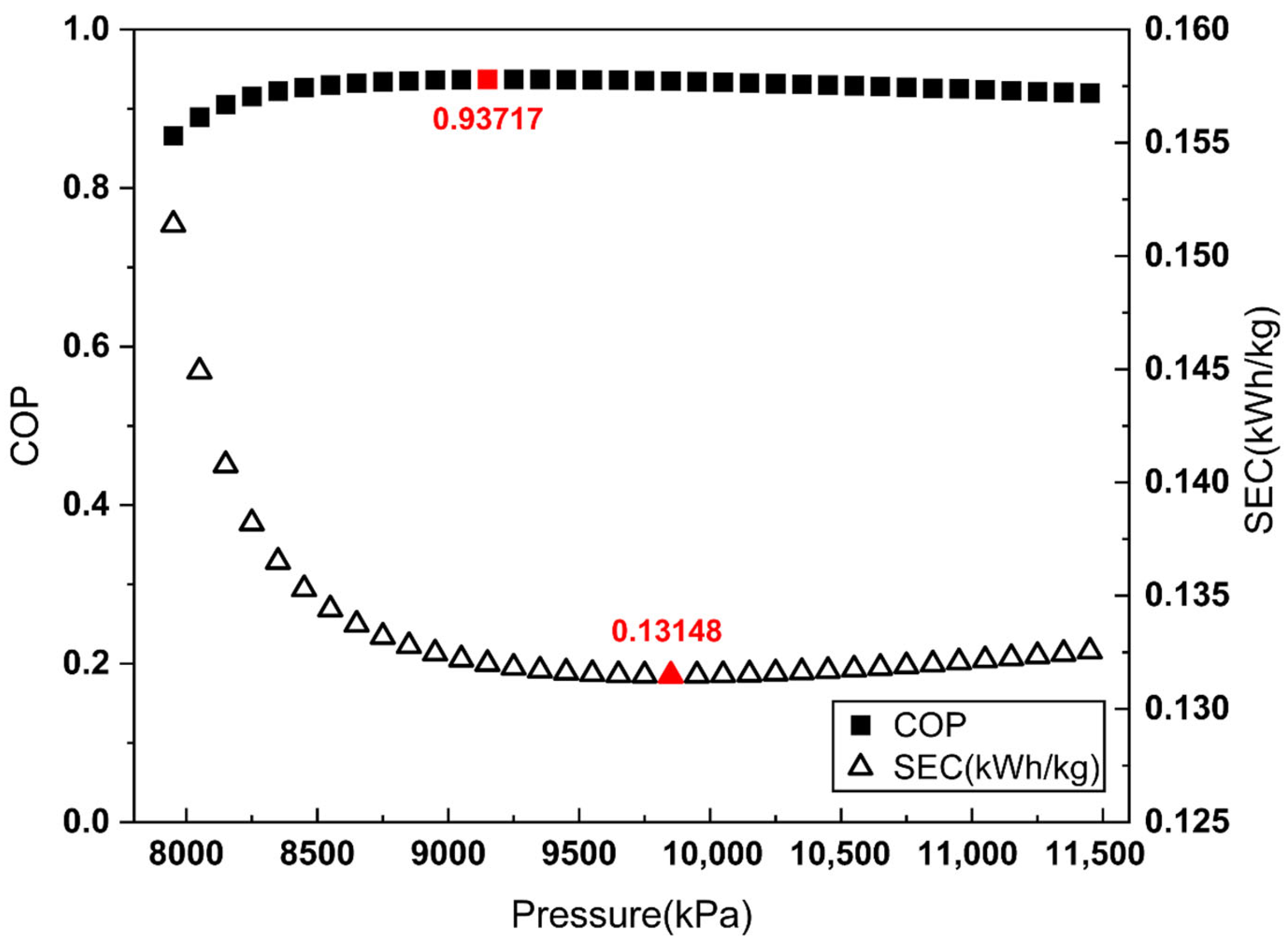
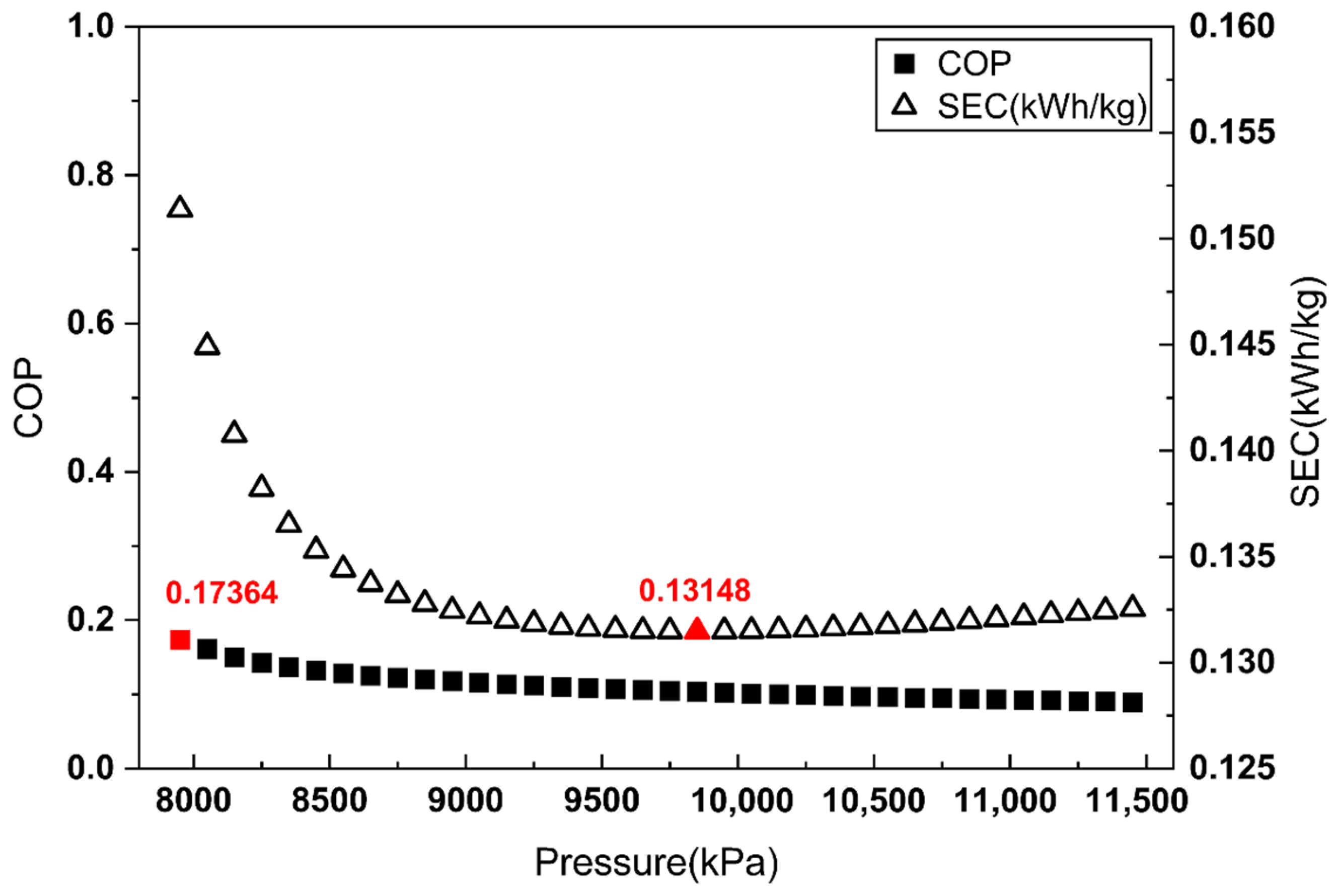

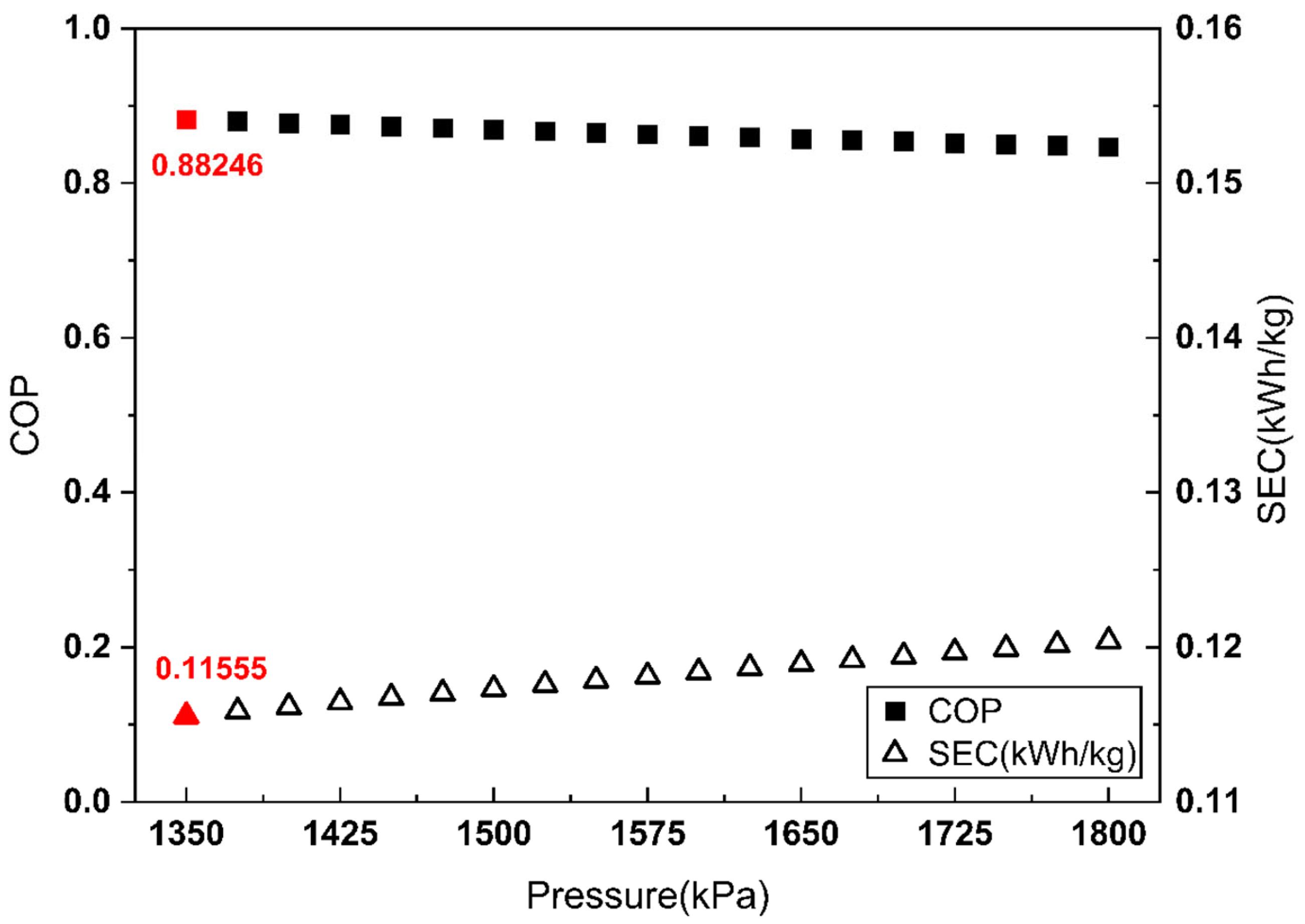
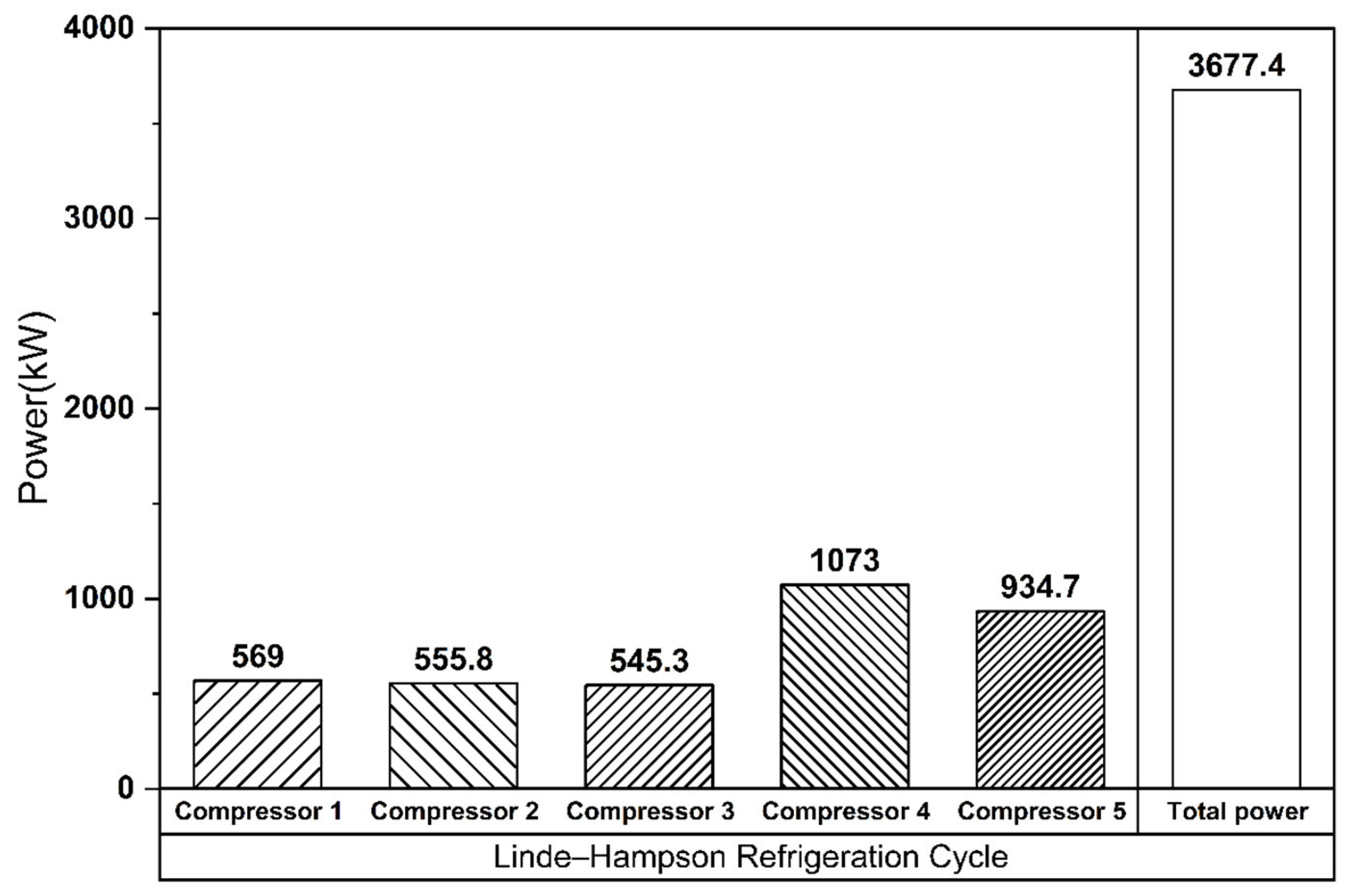
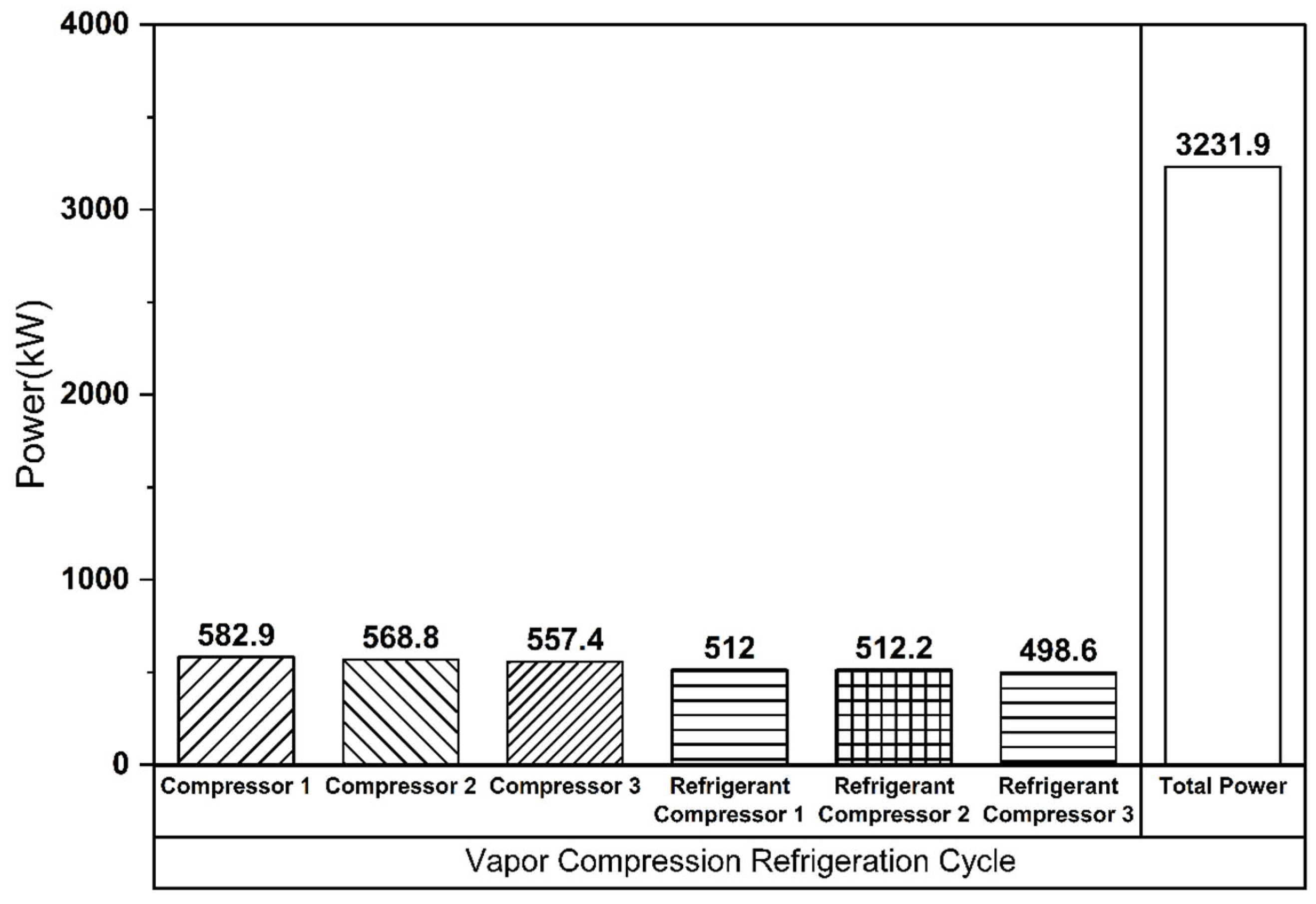
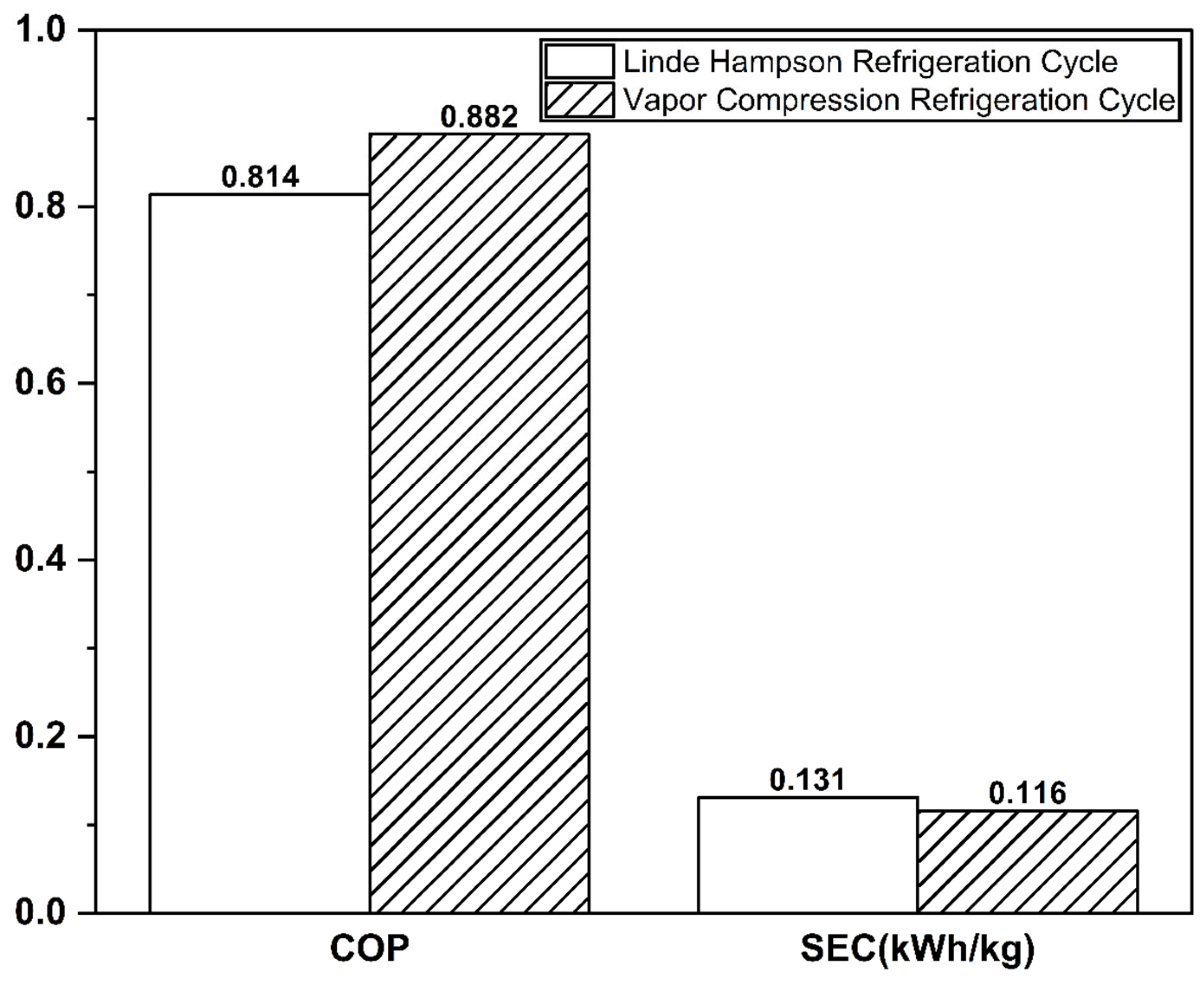
| Item | Unit | Value |
|---|---|---|
| Cargo capacity | m3 | 174,000 |
| Main fuel | - | LNG |
| Engine | - | WinGD 5X72DF-C2.1 (2 set) |
| Exhaust gas mass flow | kg/h | 140,942 |
| Capture rate | % | 90 |
| CO2 concentration | mol % | 14.98 |
| Captured gas mass flow | kg/h | 27,970 |
| Stream Number | 1 | 2 | 3 | 4 | 5 | 6 |
| Vapor fraction | 1.000 | 1.000 | 1.000 | 1.000 | 1.000 | 0.000 |
| Pressure (kPa) | 150 | 1550 | 1500 | 1500 | 9950 | 9900 |
| Temperature (°C) | 40.00 | 116.3 | 35.00 | 33.63 | 128.7 | 35.00 |
| Flow rate (kg/h) | 27,970 | 27,970 | 27,970 | 51,403 | 51,403 | 51,403 |
| Stream Number | 7 | 8 | 9 | 10 | 11 | - |
| Vapor fraction | 0.000 | 0.456 | 0.000 | 1.000 | 1.000 | - |
| Pressure (kPa) | 9850 | 1500 | 1500 | 1500 | 1500 | - |
| Temperature (°C) | 28.58 | −27.71 | −27.71 | −27.71 | 32.00 | - |
| Flow rate (kg/h) | 51,403 | 51,403 | 27,970 | 23,433 | 23,433 | - |
| Stream Number | 1 | 2 | 3 | 4 | 5 |
| Vapor fraction | 1.000 | 1.000 | 1.000 | 1.000 | 1.000 |
| Pressure (kPa) | 150 | 358.9 | 308.9 | 739.3 | 689.3 |
| Temperature (°C) | 40.00 | 123.4 | 35.00 | 117.7 | 35.00 |
| Flow rate (kg/h) | 27,970 | 27,970 | 27,970 | 27,970 | 27,970 |
| Stream Number | 6 | 7 | 8 | 9 | 10 |
| Vapor fraction | 1.000 | 1.000 | 0.000 | 0.000 | 1.000 |
| Pressure (kPa) | 1650 | 1600 | 1550 | 1500 | 1500 |
| Temperature (°C) | 118.3 | 35.00 | −27.70 | −27.71 | −27.71 |
| Flow rate (kg/h) | 27,970 | 27,970 | 27,970 | 27,970 | 0.000 |
| Stream Number | 11 | 12 | 13 | 14 | 15 |
| Vapor fraction | 0.000 | 1.000 | 1.000 | 1.000 | 1.000 |
| Pressure (kPa) | 1500 | 100 | 266.3 | 216.3 | 576 |
| Temperature (°C) | −27.71 | 32.00 | 132.2 | 35.00 | 136.1 |
| Flow rate (kg/h) | 27,970 | 8531 | 8531 | 8531 | 8531 |
| Stream Number | 16 | 17 | 18 | 19 | - |
| Vapor fraction | 1.000 | 1.000 | 0.000 | 0.233 | - |
| Pressure (kPa) | 526 | 1400 | 1350 | 101.3 | |
| Temperature (°C) | 35.00 | 136.7 | 35.00 | −33.26 | - |
| Flow rate (kg/h) | 8531 | 8531 | 8531 | 8531 | - |
| Item | Linde–Hampson Refrigeration Cycle | Vapor Compression Refrigeration Cycle | Relative Difference (%) |
|---|---|---|---|
| COP | 0.814 | 0.882 | 8.35 |
| SEC (kWh/kg) | 0.131 | 0.116 | 11.45 |
Disclaimer/Publisher’s Note: The statements, opinions and data contained in all publications are solely those of the individual author(s) and contributor(s) and not of MDPI and/or the editor(s). MDPI and/or the editor(s) disclaim responsibility for any injury to people or property resulting from any ideas, methods, instructions or products referred to in the content. |
© 2025 by the authors. Licensee MDPI, Basel, Switzerland. This article is an open access article distributed under the terms and conditions of the Creative Commons Attribution (CC BY) license (https://creativecommons.org/licenses/by/4.0/).
Share and Cite
Park, S.; Ji, S.; Cheon, Y.; Lee, J. Design and Thermodynamic Analysis of CO2 Liquefaction Processes for Onboard Carbon Capture and Storage. J. Mar. Sci. Eng. 2025, 13, 1976. https://doi.org/10.3390/jmse13101976
Park S, Ji S, Cheon Y, Lee J. Design and Thermodynamic Analysis of CO2 Liquefaction Processes for Onboard Carbon Capture and Storage. Journal of Marine Science and Engineering. 2025; 13(10):1976. https://doi.org/10.3390/jmse13101976
Chicago/Turabian StylePark, Sejun, Sangmin Ji, Yujin Cheon, and Jinkwang Lee. 2025. "Design and Thermodynamic Analysis of CO2 Liquefaction Processes for Onboard Carbon Capture and Storage" Journal of Marine Science and Engineering 13, no. 10: 1976. https://doi.org/10.3390/jmse13101976
APA StylePark, S., Ji, S., Cheon, Y., & Lee, J. (2025). Design and Thermodynamic Analysis of CO2 Liquefaction Processes for Onboard Carbon Capture and Storage. Journal of Marine Science and Engineering, 13(10), 1976. https://doi.org/10.3390/jmse13101976







